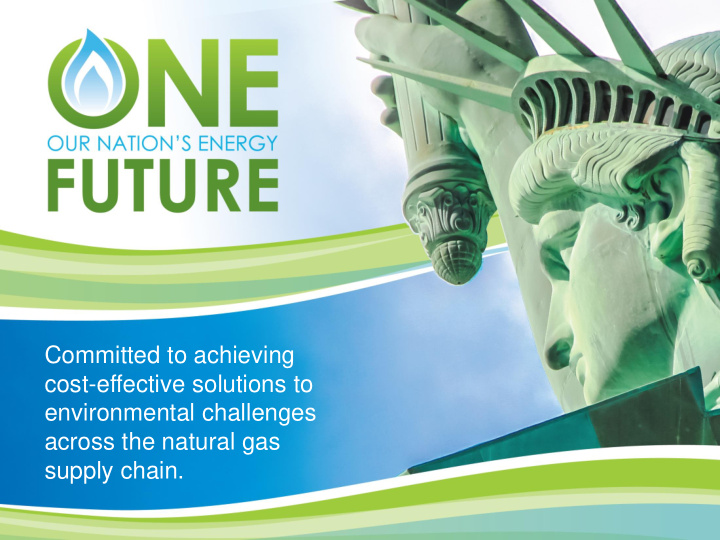



Committed to achieving cost-effective solutions to environmental challenges across the natural gas supply chain.
ONE Future Companies
Our Approach • Industry-led initiative to lower methane emissions across the natural gas supply chain. • It’s a win -win : By reducing methane emissions across the natural gas supply chain, ONE Future companies deliver more value to our customers, while also meaningfully reducing greenhouse gas emissions. • Focus on methane because natural gas is primarily methane 3
Why make the commitment? • Safety: Ensure safe and reliable operations for our employees and communities • Responsibility : To be responsive to our customers, shareholders and investment communities • Industry Leadership : To support US’ energy -dominance goals and continued growth • Sustainability: To support the role that natural gas can play in a sustainable energy economy • We support science, innovation and minimizing risk. 4
Our Experience Supports a Performance-based Approach Set an ambitious Allow flexibility target Focus on cost- Get results fast effectiveness Insist on Foster innovation scientific integrity
Industry is reducing emissions • According to EPA data, between 1990 and 2016, methane emissions from natural gas systems in the U.S. declined ~16% despite natural gas production increasing 49% in the same amount of time. (a) (b) • The United States has reduced its greenhouse gas emissions and achieved major improvements to air quality, while meeting our energy security needs. a) U.S. EPA, Draft Inventory of U.S. Greenhouse Gas Emissions and Sinks, Feb. 6, 2018. b) U.S. EIA, U.S. Dry Natural Gas Production, Jan. 2018 6
Key Principles 1. Natural Gas has a foundational role in a low carbon environment 2. Efficiency improvements (methane management & mitigation) needs a value-chain approach 3. Performance targets should be ambitious and scientific – The 1% goal, ~33% reduction Program should focus on the outcome – i.e., 4. performance-based – Baseline development is not required 5. Flexibility is key – Should not mandate a specific mitigation technology or practice – Account for year-to-year variation by acquisitions and divestitures 6. Past performance of companies should be credited 7. Reporting must be transparent and consistent with existing reporting programs 7
ONE Future-EPA Partnership – A model for private- public partnership • ONE Future proposed the “performance - based” design • EPA developed the technical reporting elements in consultation with ONE Future companies • ONE Future option offers the lowest cost option for reducing methane emissions without mandating specific technologies or practices • The value-chain approach allows firms to better share and understand technical, operations and policy limitations 8
ONE Future is Part of EPA Methane Challenge • Performance-based approach to meet 2025 goals – Technology agnostic – Transparent and Consistent Reporting using EPA-ONE Future protocols Methane Emissions Methane Emission Intensity Goals Intensity (percent of Gross Production) Industry Segment 2012 2020 2025 Gas Production and Gathering 0.55% 0.46% 0.36% Gas Processing 0.18% 0.15% 0.11% Gas Transmission and Storage 0.44% 0.37% 0.30% Gas Distribution 0.26% 0.24% 0.22% Total 1.44% 1.22% 1.00%
ONE Future-DOE Partnership – A model for private- public partnership • Technical and policy expertise across the value- chain – NETL Lifecycle Analysis – CSU GEF Project – Peer-review of reports • Advancing methane detection and measurement science • Supporting DOE’s international outreach – Mexico, Israel and Argentina 10
ONE Future-Technology R&D and Best Practices • Technological R&D – Drones w/ Methane sensors – Fence-line methane sensors – Mobile methane sensors – Sensors that characterize and QUANTIFY methane emissions • Methane capture and recovery systems to minimize station blowdown emissions • Pipeline Integrity Management Principles instead of pipe repair/replacements to minimize blowdown emissions 11
Conclusions 1. Our commitment to methane reductions goes beyond typical “sustainability” concerns 2. ONE Future is a performance-based design that achieves reductions more cost-effectively 3. Technology R&D and Lessons learned should inform future policy decisions ONE Future values the EPA’s role and supports 4. maintaining the Methane Challenge Program ONE Future values the DOE’s role in supporting 5. applied research in methane detection and measurement 12
Methane Challenge – ONE Future Emissions Intensity Option
Recommend
More recommend